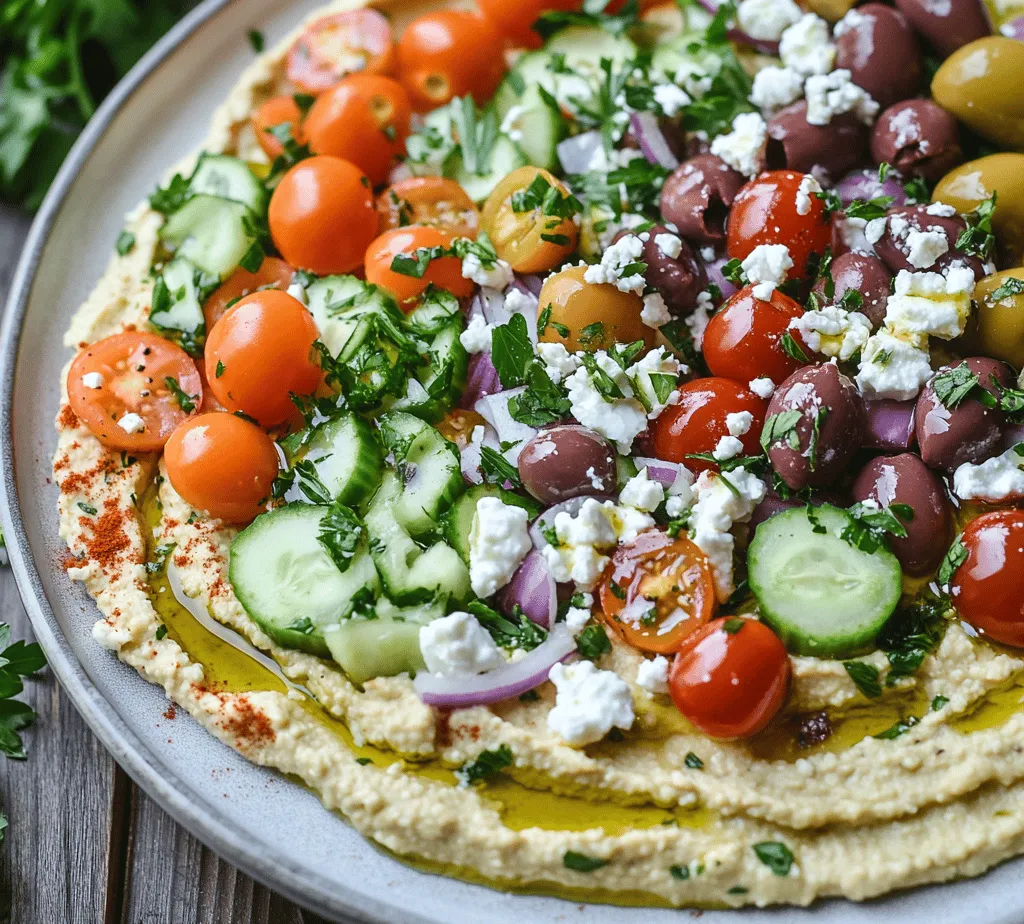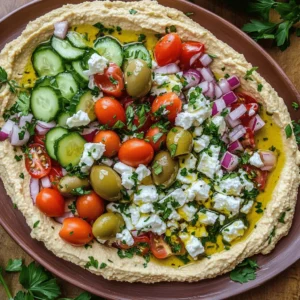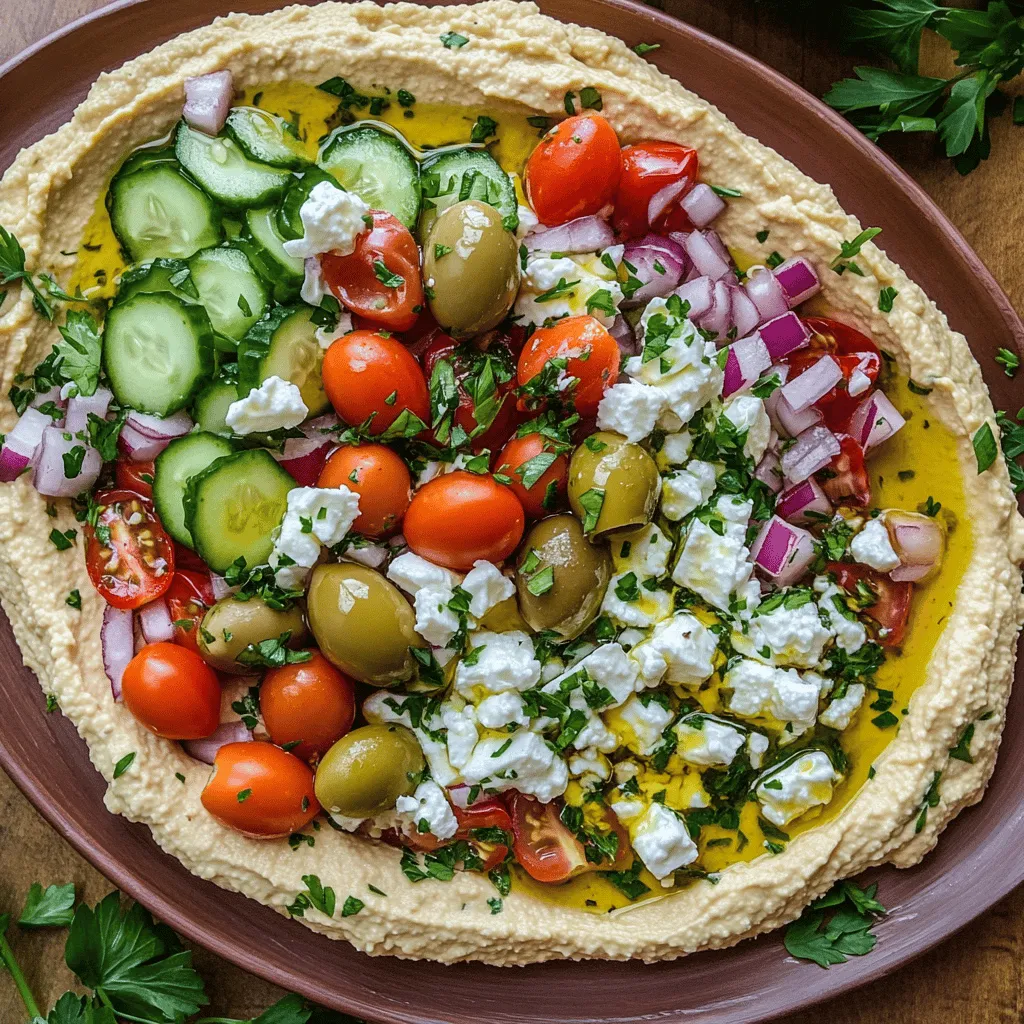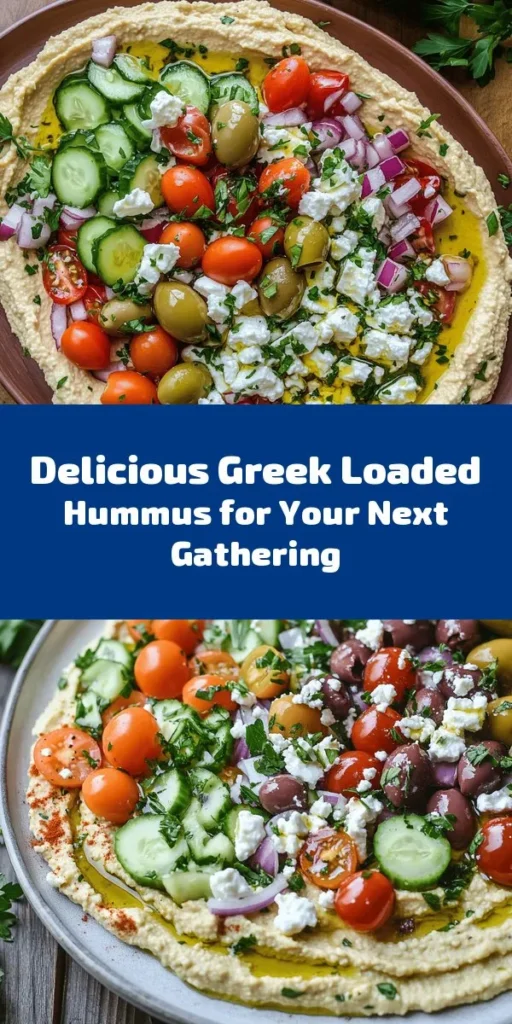Introduction
Hummus, a creamy and nutritious dip made primarily from chickpeas, has become a beloved staple in kitchens around the world. Originating from the Mediterranean region, this versatile dish is celebrated not only for its rich flavor but also for its incredible health benefits. In this article, we will delve into the delightful world of Greek Style Loaded Hummus, a vibrant twist on the classic recipe that elevates hummus to new heights with fresh toppings and bold flavors.
The Greek Style Loaded Hummus is not just a dip; it’s a meal in itself, packed with protein, fiber, and a plethora of vitamins and minerals. Chickpeas, the primary ingredient in hummus, are known for their ability to promote heart health, support digestion, and provide sustained energy. This recipe showcases the versatility of hummus, allowing it to be customized with a variety of toppings that not only enhance the taste but also add a burst of color and nutrition.
One of the most appealing aspects of Greek Style Loaded Hummus is the array of fresh, colorful toppings that make each bite exciting. Think diced cucumbers, ripe tomatoes, Kalamata olives, crumbled feta cheese, and a sprinkle of fresh herbs. These toppings not only amplify the flavor of the hummus but also contribute to its visual appeal, making it an impressive appetizer for gatherings or a healthy snack for any time of the day.
The Nutritional Value of Hummus
Hummus is not just a delicious dip; it is a nutritional powerhouse primarily due to its main ingredient, chickpeas. Chickpeas are rich in protein, making them an excellent plant-based protein source for vegetarians and vegans. They are also high in dietary fiber, which aids in digestion and helps to keep you feeling full longer. Additionally, chickpeas contain essential vitamins and minerals such as folate, iron, and magnesium, contributing to overall health and well-being.
Tahini, another key ingredient in hummus, is made from ground sesame seeds and adds a unique flavor and creaminess to the dip. It is packed with healthy fats, particularly monounsaturated fats, which are beneficial for heart health. Tahini is also a good source of calcium, which is vital for bone health, and contains antioxidants that help combat inflammation in the body.
Incorporating fresh vegetables and herbs as toppings not only enhances the flavor profile but also boosts the nutritional value of your hummus. Ingredients like tomatoes and cucumbers are low in calories and high in vitamins A and C, while herbs such as parsley and mint offer additional antioxidants and anti-inflammatory properties. Lastly, drizzling high-quality olive oil on top of your hummus adds healthy fats and enhances the overall flavor, making this dish a wholesome and satisfying option.
Ingredients Breakdown
Before diving into the preparation of Greek Style Loaded Hummus, it’s essential to understand the ingredients that will come together to create this delicious dish. Each component plays a significant role in achieving the perfect balance of flavor, texture, and nutrition.
1. Chickpeas: The star of the show, chickpeas provide the base for your hummus. You can use canned chickpeas for convenience, or soak and cook dried ones for a fresher taste. For those looking to reduce sodium intake, opting for dried chickpeas is a great choice as you can control the seasoning.
2. Tahini: This sesame seed paste adds creaminess and a nutty flavor to the hummus. If you have a sesame allergy, you can substitute tahini with sunbutter or omit it altogether, although this will slightly change the flavor and texture.
3. Olive Oil: A key ingredient that not only adds richness but also enhances the flavor of the hummus. Extra virgin olive oil is recommended for its superior taste and health benefits. For a variation, you might consider flavored oils, such as garlic-infused olive oil, to add an extra layer of depth.
4. Garlic: Fresh garlic gives hummus a distinctive flavor. If you prefer a milder taste, you can use roasted garlic instead, which has a sweeter, less pungent flavor.
5. Lemon Juice: Freshly squeezed lemon juice brightens up the hummus and balances the richness of the tahini and olive oil. For a different flavor profile, you can substitute lime juice or add a splash of vinegar for acidity.
6. Salt and Pepper: Essential for seasoning. Adjust the amount according to your taste preference. If you’re mindful of sodium, consider using herbs or spices to enhance flavor without added salt.
7. Toppings: The options are endless, but typical toppings for Greek Style Loaded Hummus include diced cucumbers, cherry tomatoes, Kalamata olives, crumbled feta cheese, and a sprinkle of fresh herbs like parsley or dill. You can mix and match based on your preferences or what you have on hand.
Quality ingredients are crucial for achieving the best flavor in your hummus. Opt for organic and fresh produce whenever possible, as this will significantly enhance the taste and nutritional content of your dish.
Preparing the Hummus Base
Now that we’ve covered the ingredients, let’s dive into the preparation of the hummus base. The process is straightforward, but there are some key techniques that can help you achieve the perfect texture and flavor.
Step 1: Preparing the Chickpeas
If you’re using dried chickpeas, start by soaking them in water overnight. This will help soften the beans and reduce cooking time. After soaking, drain and rinse them, then boil in fresh water for about 1 to 1.5 hours until tender. If you’re using canned chickpeas, simply drain and rinse them thoroughly to remove excess salt and preservatives.
Step 2: Blending the Ingredients
In a high-speed blender or food processor, combine the prepared chickpeas, tahini, minced garlic, lemon juice, and a generous pinch of salt. Blend until the mixture starts to come together.
Step 3: Adjusting Texture and Flavor
As you blend, slowly drizzle in the olive oil and a couple of tablespoons of water to help achieve a smooth, creamy consistency. The amount of water needed may vary depending on the moisture content of the chickpeas. Keep blending until the hummus is velvety; scrape down the sides of the bowl as needed. Taste and adjust the seasoning with additional salt, lemon juice, or garlic according to your preference.
Step 4: Achieving the Perfect Consistency
For a lighter, fluffier hummus, blend for a longer period. If you prefer a thicker version, you can reduce the amount of water or olive oil added. Remember, it’s essential to taste as you go; this will allow you to create a hummus that perfectly suits your palate.
Creating the Perfect Topping Mix
With the hummus base prepared, it’s time to focus on the toppings that will elevate your dish. The beauty of Greek Style Loaded Hummus lies in its ability to be customized with various toppings, each contributing their unique flavor and texture.
Suggested Topping Ingredients
– Diced Cucumbers: Fresh and crunchy, they add a refreshing contrast to the creamy hummus.
– Cherry Tomatoes: Sweet and juicy, these provide a burst of flavor and vibrant color.
– Kalamata Olives: Their briny flavor enhances the overall taste, giving a nod to the Mediterranean origin of the dish.
– Feta Cheese: Crumbled for a salty, tangy bite that complements the other ingredients beautifully.
– Fresh Herbs: Parsley, dill, or mint can be used to add aromatic freshness and a pop of color.
Arranging the Toppings
When it comes to assembling your Greek Style Loaded Hummus, presentation is key. Use a shallow dish to spread out the hummus evenly. Arrange the toppings artistically, allowing each ingredient to shine through. Drizzle with olive oil and perhaps a sprinkle of smoked paprika or za’atar for an added visual appeal and flavor dimension.
The combination of these toppings not only enhances the taste of the hummus but also provides a colorful and enticing presentation that will impress your guests.
Stay tuned for the next part of this article where we will explore serving suggestions and answer some common questions about Greek Style Loaded Hummus, ensuring that you have everything you need to create this delightful dish at home!

Suggestions for Variations in Toppings
When it comes to toppings for Greek Style Loaded Hummus, the possibilities are virtually endless, allowing you to tailor the dish to your personal taste or the season. Here are some ideas for variations that can elevate your hummus experience:
– Seasonal Vegetables: Incorporate fresh, seasonal produce like asparagus in spring, roasted bell peppers in summer, or sweet potatoes in fall. Each vegetable adds its unique flavor profile and nutritional benefits.
– Herbs and Greens: Consider garnishing with fresh herbs such as dill, parsley, or mint for a burst of freshness. You can also add microgreens or arugula for a peppery kick.
– Feta Cheese: Crumbled feta can add a salty, creamy element that complements the smoothness of the hummus. For a vegan option, use a dairy-free feta alternative.
– Olives: A medley of olives, such as Kalamata or green olives, provides a briny contrast that enhances the overall flavor.
– Nuts and Seeds: Toasted pine nuts or sunflower seeds can provide a delightful crunch and additional nutrition. A sprinkle of sesame seeds can also echo the tahini flavor in the hummus.
– Spices: Experiment with different spices like smoked paprika, za’atar, or sumac to add depth and complexity to the dish.
Assembling Your Greek Style Loaded Hummus
Plating and Presentation
To truly impress your guests, the presentation of your Greek Style Loaded Hummus is key. Start by spooning your prepared hummus onto a large serving platter or a shallow bowl. Use the back of the spoon to create a swirling pattern in the hummus, which not only looks attractive but also creates little pockets for your toppings.
Next, artfully arrange your chosen toppings across the surface of the hummus. This can include drizzling with olive oil, sprinkling fresh herbs, and placing your vegetables, nuts, or olives in an aesthetically pleasing manner. The goal is to create a colorful and inviting display that showcases the vibrant hues of the toppings, enticing guests to dive in.
Importance of Visual Appeal in Serving Dishes
Visual appeal plays a significant role when serving food, especially in communal dining cultures. A beautifully presented dish can stimulate the appetite and set the stage for a delightful meal. When guests see a colorful array of toppings on the hummus, it invites them to experience the various textures and flavors, enhancing the overall tasting experience.
Suggestions for Serving Vessels and Accompaniments
Choose serving vessels that complement your dish. A rustic wooden board can add a homey touch, while a sleek white platter keeps the focus on the vibrant colors of the hummus and its toppings. For accompaniments, consider serving with an assortment of:
– Pita Bread: Warm, soft pita bread is classic for dipping and adds a chewy texture.
– Vegetable Sticks: Fresh, crunchy vegetables like carrots, cucumbers, and bell peppers not only add texture but also contribute to a healthy serving.
– Crackers: Offer a variety of crackers, including whole grain or gluten-free options, to cater to different dietary preferences.
Serving Suggestions
Greek Style Loaded Hummus is incredibly versatile and can be enjoyed in multiple ways, making it perfect for any occasion.
– Dipping Pairings: The classic pairing of pita bread, vegetable sticks, and crackers makes for a great appetizer at parties or gatherings. Create a vibrant dip platter that encourages sharing and experimentation.
– Creative Serving Ideas: Transform your hummus into a centerpiece for entertaining by serving it alongside a charcuterie board or as part of a mezze spread. You can also package small portions in jars for meal prep or lunchboxes, providing a healthy snack option that’s easy to grab on the go.
– Incorporating into Meals: Greek Style Loaded Hummus can be used creatively in meals as well. Spread it on sandwiches or wraps for added creaminess, dollop it on salads for a protein boost, or serve it as a side with grilled meats or roasted vegetables. Its versatility ensures it can fit smoothly into a variety of culinary contexts.
Storage and Shelf Life
To ensure your Greek Style Loaded Hummus stays fresh and delicious, it’s essential to follow best practices for storage.
– Storing Leftover Hummus: Store any leftover hummus in an airtight container in the refrigerator. It can typically last for about 4 to 5 days.
– Preserving Freshness of Toppings: If you have topped your hummus, it’s best to store the toppings separately to maintain their freshness and texture. When ready to serve again, simply add the toppings back onto the hummus.
– Signs of Spoilage: Always check for signs of spoilage before consuming leftovers. If the hummus has developed an off smell, strange texture, or any discoloration, it’s best to discard it.
Cultural Significance of Hummus in Greek Cuisine
Hummus has deep roots in Mediterranean culture, with variations found across many countries, including Greece. Believed to have originated in the Levant region, hummus has evolved over centuries and has become a staple in Greek cuisine.
– A Brief History: Hummus is thought to date back to ancient civilizations. Its core ingredients—chickpeas and tahini—are rich in nutrients and provide a healthy source of protein, making it a beloved dish among Mediterranean cultures.
– Traditional Greek Meals: In Greece, hummus is often served as part of a larger mezze platter, which includes an array of appetizers like dolmades, tzatziki, and olives. This communal style of dining encourages sharing and interaction, bringing people together over food.
– Role in Communal Dining: Hummus symbolizes hospitality in Greek culture, often served to guests as a welcome gesture. It is not just about nourishing the body, but also about fostering connections and creating memorable dining experiences.
Conclusion
Greek Style Loaded Hummus stands out not only for its delightful flavors but also for its myriad health benefits. Packed with protein, healthy fats, and fiber, this dish is an excellent choice for those seeking a nutritious yet satisfying meal or snack.
Its versatility allows for endless experimentation with different flavors and toppings, making it a perfect addition to any meal or gathering. Whether you choose to stick with traditional toppings or venture into seasonal variations, each experience with this dish can be unique and personalized.
Encouraging creativity in the kitchen, Greek Style Loaded Hummus invites you to explore new ingredients and flavors. So, gather your ingredients, invite some friends, and enjoy crafting this delicious dish that embodies the essence of Greek hospitality!



